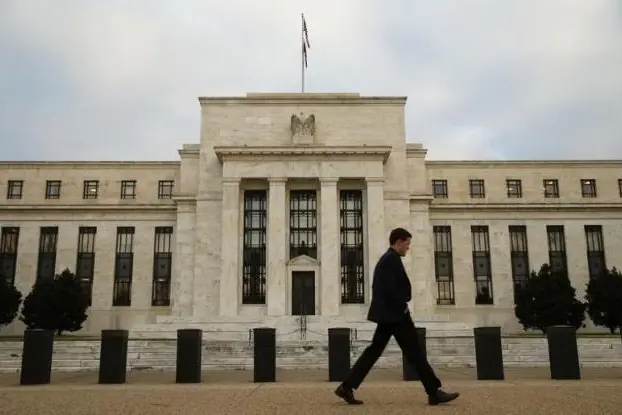PHOTO
LONDON- The U.S. government's finances are on an unsustainable trajectory and are likely to worsen further after the mid-term elections, adding to the list of problems facing the global economy and oil markets in 2019/2020.
The U.S. federal government's outlays exceeded its receipts by $779 billion in Fiscal Year 2018, which ended on Sept. 30, according to the Congressional Budget Office ("Monthly budget review", CBO, Nov. 7).
The budget deficit would have been even worse at $823 billion if certain outlays had not been brought forward and recorded in the previous financial year because the first day of Fiscal 2018 fell on a weekend.
Even so, the deficit increased to 3.8 percent of gross domestic product, up from 3.5 percent the previous year, and the highest since Fiscal 2013, when the economy was still recovering from the global financial crisis.
Government receipts increased by just $14 billion (less than 1 percent) while outlays rose by $127 billion (around 3 percent), worsening the deficit by $113 billion compared with the previous year.
Higher receipts from individual income taxes (+$96 billion), payroll taxes (+$9 billion) and customs duties (+$7 billion) were mostly offset by lower collections from corporate income taxes (-$92 billion) and fines (-$7 billion).
Government outlays increased for net interest on the public debt (+$62 billion), social security (+$43 billion), defence (+$38 billion), Medicare (+$16 billion) and Medicaid (+$14 billion).
Increased government spending, especially on defence, has helped fuel the acceleration in economic growth ("A big reason U.S. economy is accelerating; government spending", Wall Street Journal, Oct. 25).
But the federal government's deteriorating financial position and increased borrowing needs are also driving up yields on Treasury securities affecting borrowing costs across the entire economy and worldwide.
Yields on 10-year U.S. Treasury notes have risen to more than 3.2 percent, more than double the recent low in 2016, and the highest since 2011.
Tax cuts and increased spending at a relatively late point in the economic cycle have also encouraged the Federal Reserve to keep raising interest rates in order to hold inflationary pressure in check.
The combination of fiscal stimulus and tightening monetary policy has caused the exchange rate to appreciate, worsening the trade deficit as exporters and import-competing firms lose competitiveness to foreign rivals.
In effect, the economy is being over-stimulated by fiscal policy and the resulting imbalance is showing up in rising interest rates, increasing borrowing costs, an appreciating exchange rate and a widening trade deficit.
DETERIORATING OUTLOOK
Government borrowing is likely to increase over the next two years, making all these financial imbalances even worse, and creating a major source of vulnerability in the global economy.
The Congressional Budget Office has forecast the budget deficit will worsen to around $1 trillion (around 4.5 percent of GDP) in both Fiscal 2019 and Fiscal 2020 ("The budget and economic outlook", CBO, April 2018).
In practice, the government's financial position is likely to deteriorate even more than this as the president and Congress compete for votes ahead of the next elections by seeking to extend tax cuts and raise spending.
With Congress divided between a Democrat-controlled House of Representatives and a Republican-controlled Senate, legislators are unlikely to agree on either spending cuts or tax increases to contain the deficit.
Instead, lawmakers and the president are more likely to try to please their core supporters by agreeing to extend selected tax breaks and spending programmes in a bid to buy votes ahead of the next election in 2020.
President Donald Trump has already indicated he wants to work with congressional Democrats on a big infrastructure bill saying on Wednesday "we have a lot of things in common on infrastructure".
Funding for major infrastructure programmes could come from the federal government, state and local governments, or private sources.
Federal government funding would hit the deficit directly. Funding from state and local sources or the private sector, perhaps with tax incentives, would further stimulate an economy already operating close to full capacity.
If the economy starts to slow in 2019 or 2020, the president and congressional leaders will push for even more tax cuts and higher spending to offset the slowdown.
Even more than other administrations, the current White House has linked its credibility to the strength of the economy and a rising stock market, so it will do everything possible to avert a recession between now and 2020.
The most likely scenario is that the fiscal position will continue to deteriorate in 2019/2020, keeping upward pressure on interest rates, borrowing costs, the exchange rate and the trade deficit.
This course is obviously unsustainable over the long run, although it is not clear whether it can be kept going for at least two more years until after the next election.
In the meantime, the risk of sudden and disruptive changes in inflation, interest rates, asset prices or the exchange rate are a major source of risk to the global economy and oil consumption in 2019/2020.
(Editing by David Evans) ((john.kemp@thomsonreuters.com; and on twitter @JKempEnergy))












